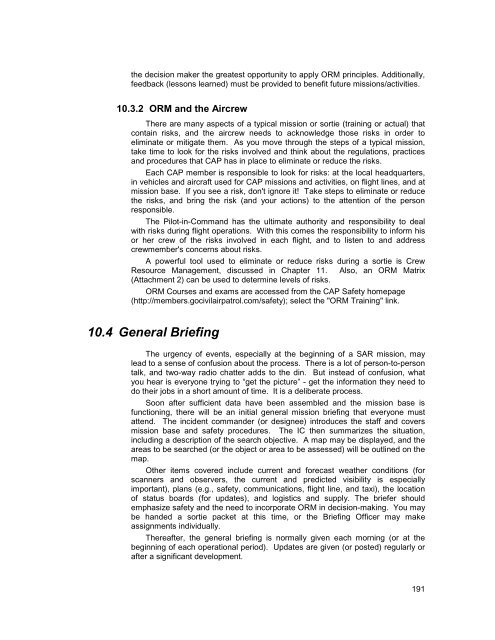MART Vol. II MO/MP - NESA - Civil Air Patrol
MART Vol. II MO/MP - NESA - Civil Air Patrol
MART Vol. II MO/MP - NESA - Civil Air Patrol
You also want an ePaper? Increase the reach of your titles
YUMPU automatically turns print PDFs into web optimized ePapers that Google loves.
the decision maker the greatest opportunity to apply ORM principles. Additionally,feedback (lessons learned) must be provided to benefit future missions/activities.10.3.2 ORM and the <strong>Air</strong>crewThere are many aspects of a typical mission or sortie (training or actual) thatcontain risks, and the aircrew needs to acknowledge those risks in order toeliminate or mitigate them. As you move through the steps of a typical mission,take time to look for the risks involved and think about the regulations, practicesand procedures that CAP has in place to eliminate or reduce the risks.Each CAP member is responsible to look for risks: at the local headquarters,in vehicles and aircraft used for CAP missions and activities, on flight lines, and atmission base. If you see a risk, don't ignore it! Take steps to eliminate or reducethe risks, and bring the risk (and your actions) to the attention of the personresponsible.The Pilot-in-Command has the ultimate authority and responsibility to dealwith risks during flight operations. With this comes the responsibility to inform hisor her crew of the risks involved in each flight, and to listen to and addresscrewmember's concerns about risks.A powerful tool used to eliminate or reduce risks during a sortie is CrewResource Management, discussed in Chapter 11. Also, an ORM Matrix(Attachment 2) can be used to determine levels of risks.ORM Courses and exams are accessed from the CAP Safety homepage(http://members.gocivilairpatrol.com/safety); select the "ORM Training" link.10.4 General BriefingThe urgency of events, especially at the beginning of a SAR mission, maylead to a sense of confusion about the process. There is a lot of person-to-persontalk, and two-way radio chatter adds to the din. But instead of confusion, whatyou hear is everyone trying to “get the picture” - get the information they need todo their jobs in a short amount of time. It is a deliberate process.Soon after sufficient data have been assembled and the mission base isfunctioning, there will be an initial general mission briefing that everyone mustattend. The incident commander (or designee) introduces the staff and coversmission base and safety procedures. The IC then summarizes the situation,including a description of the search objective. A map may be displayed, and theareas to be searched (or the object or area to be assessed) will be outlined on themap.Other items covered include current and forecast weather conditions (forscanners and observers, the current and predicted visibility is especiallyimportant), plans (e.g., safety, communications, flight line, and taxi), the locationof status boards (for updates), and logistics and supply. The briefer shouldemphasize safety and the need to incorporate ORM in decision-making. You maybe handed a sortie packet at this time, or the Briefing Officer may makeassignments individually.Thereafter, the general briefing is normally given each morning (or at thebeginning of each operational period). Updates are given (or posted) regularly orafter a significant development.191














